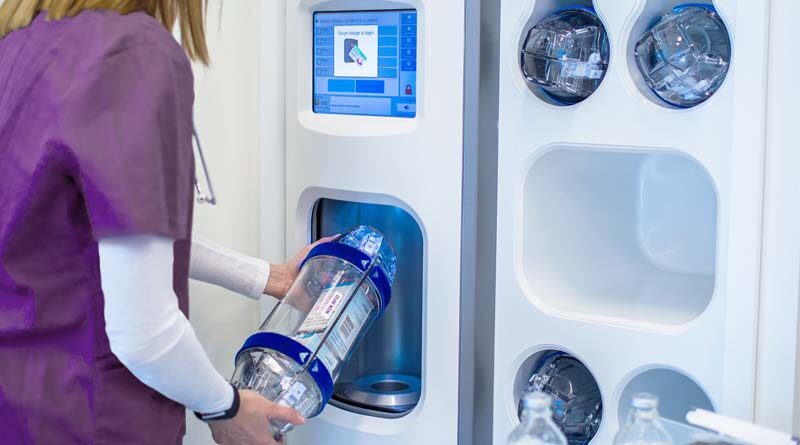Pneumatic Tube Systems Help Deliver Better Patient Care
By Swisslog Healthcare
Every twenty seconds, a carrier is dispatched within one of the 2,400 hospitals equipped with a Swisslog Healthcare TransLogic® pneumatic tube system (PTS). Three out of every ten carriers contain patient specimens destined for the laboratory for tests. Two out of every ten carriers contain medication intended for patient care areas.
The significance of reliably, swiftly and securely moving material between hospital service areas might be marginalized by some. Not by clinicians and staff.
Turnaround times, workflow efficiency, and time to treat are top of mind for them. And the PTS plays an essential role in facilitating the work tasks associated with the handoff of specimens to the Laboratory, provisioning the Emergency Department with blood products, and delivering medication necessary for patient treatment plans.
The many people who interact with the pneumatic tube system each day have a deep appreciation for the job-enhancing features of the TransLogic Nexus® station, how Xpress™ equipment quickly and efficiently processes high volumes of carrier traffic, and overall high levels of TransLogic PTS system availability.
By concentrating our innovation, service, and consulting capabilities on enhancing user experiences with our products, we help clinicians and caregivers deliver better care to patients. We’re continually in search of ways to equip our customers with automated transport solutions that serve the needs of facilities now and for years to come.
Pneumatic tube systems are a 30+ year investment for hospitals. Key stakeholders see their investment maximized by collaborating with the Swisslog Healthcare’s System Design Analysis (SDA) team for the purpose of choosing the optimal PTS system for a new or expanding facility or optimizing the performance of an existing system.
With more than 100 years’ experience partnering with facilities management, laboratory directors, pharmacy leaders and operations executives, the System Design Analysis team at Swisslog Healthcare provides systematic, customer-specific analytic services for new and existing pneumatic tube systems.
Many variables influence PTS system performance. Operational changes, facility growth, increased patient care services, and adherence to a routine preventative care schedule all influence system behavior. Leveraging proprietary simulation and analysis tools, the SDA team digitally recreates a customer’s unique PTS configuration and carrier traffic. They document performance including wait and transaction times, measure uptime/downtime, and test various alterations to identify opportunities for system improvement.
Once opportunities are brought to light, the SDA team reviews options with our customers for feasibility, organizational receptiveness to change, budget, and other criteria. Our analysts work to provide customers with information and recommendations designed to optimize system performance and properly position the facility to accommodate future departmental relocations, physical expansion or additions, and demand generated by additional services.
Let’s illustrate the value of an SDA consultation for a 1,200-bed teaching hospital conducting 4,400 transactions a day that has one building with an ED, blood bank and patient services. Across the street 1,500 feet away is the inpatient pharmacy and main lab. System-wide wait times averaged 83 seconds with a traditional pressure vacuum system. A combination of excessive distance between departments and high carrier volumes led facility management to seek insight and analysis from the SDA team for ways to reduce wait time and improve throughput. Simulations generated by the team helped demonstrate gains the facility could realize by implementing TransLogic Xpress™ technology.
After implementing Xpress, wait times were reduced by 80%, down to 15 seconds. The additional throughput capability created by converting to Xpress rose from 4,400 daily transactions to 7,500 for an increase of 3,100 carrier capacity.
When a PTS system fails to meet user needs and demand, staff commonly resorts to transporting material manually to complete necessary transport tasks. As the Xpress technology at our example facility above absorbed the additional 3,100 transactions that had previously been dispatched manually, the reduction of manual labor resulted in a savings of $13,000 per day ($4mm annually).
In this day when circumstances challenge hospitals to contain costs and eliminate waste, the return on investment for a consultation with Swisslog Healthcare’s System Design Analysis team is extremely compelling.
Find out more at Swisslog Healthcare’s website to get started.
This article is designated as Branded Content and HCO News does not ensure the veracity or accuracy of the information included within.

